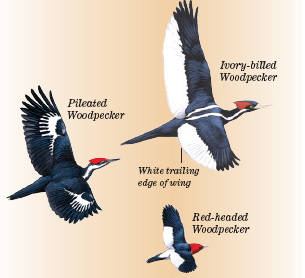U.S. to spend $27M on possibly extinct bird
U.S. to spend $27M on possibly extinct bird
mongabay.com
August 26, 2007
The U.S. government plans to spend $27 million on the recovery efforts for a bird species that may already be extinct, reports the Associated Press.
In a draft plan submitted for public comment until October 22, the Fish and Wildlife Service recommends spending millions on habitat conservation in Arkansas, Florida, Louisiana, South Carolina and Texas, on behalf of the ivory-billed woodpecker, a species believed extinct since 1944, until a group of ornithologists caused a stir in April 2004 when they claimed they had spotted the bird in a remote swamp in Arkansas. Since then, there has been vigorous debate among ornithologists whether the sighting was legitimate or a case of mistaken identity. In recent months several papers published in academic journals have argued that the birders confused the Ivory-billed Woodpecker (Campephilus principalis) with the pileated woodpecker (Dryocopus pileatus), a still common species in certain habitats.
Nevertheless the Fish and Wildlife Service has moved ahead with a 185-page blueprint for “preventing the extinction of the Ivory-billed woodpecker.”
|
Illustrations © David Allen Sibley. |
“The opportunity to recover this icon of the ornithological world cannot and should not be passed over,” said Sam Hamilton, regional director for the Service’s Southeast Region and leader of the recovery team. ‘Given the evidence pointing to its survival, we believe it would be irresponsible not to act. That’s why we established this recovery team with some of the nation’s best biologists to help us chart a reasonable, well founded path to save this species.”
“It’s the right thing to do. The Service works with its partners to prevent extinction of species like the Ivory-billed woodpecker and that is the opportunity before us now. We want to encourage interested citizens, agencies and conservation organizations to participate in the comment period. The diverse team developed a balanced, common sense approach and we look forward to receiving feedback that makes it even better.”
The Fish and Wildlife Service says that the bird’s demise was closely linked to the destruction of its habitat — hardwood swamps and pine forest in the southern United States — by loggers in the early part of the 20th century. The agency hopes that by learning more about the species’ status and ecology, it can help the species survive if it still exists.
Critics
Some are critical of the agency’s commitment of resources to a species that might already be extinct when there are other species known to be at risk.
“The identification of the bird filmed in Arkansas in April 2004 as an Ivory billed Woodpecker is best regarded as unsafe. The similarities between the Arkansas bird and known Pileated Woodpeckers suggest that it was most likely a Pileated Woodpecker,” said J. Martin Collinson, a researcher at the University of Aberdeen in Scotland, in a report published in the journal BMC Biology in March. “With no verified reports in the USA for over 50 years, it seemed impossible that a crow-sized black, white and red bird should have eluded the nation’s ornithologists, hunters and conservationists in heavily populated South-eastern USA for so long.”
John Wall, an avid birder who runs WorldTwitch.com, a birding web site, expresses similar sentiments.
“There is no credible evidence that the North American subspecies of Ivory-billed Woodpecker Campephilus principalis survived after the demise of the Singer Tract birds in the 1940s after the last substantial patch of old-growth habitat was destroyed,” he states on WorldTwitch.com.
“Further, Campephilus are noisy, conspicuous, and relatively tame. From the reports of Audubon, Tanner and Dennis (in Cuba), it is clear that the same was true of principalis,” Wall told mongabay.com. “I have encountered Campephilus species on numerous occasions while birding in forest and never have had any difficulty seeing them well.
“What can only be another routine case of misidentification of the common Pileated Woodpecker Dryocopus pileatus in good Pileated but poor Ivorybill habitat in Arkansas has been promoted as the latest Ivorybill ‘rediscovery'” concluded Wall.
Conservation groups have also expressed concern. According to an article published August 17 in Science, The Nature Conservancy, which had been buying land to conserve hardwood forest, feared that the rediscovery claims would drive up prices, making conservation more difficult.
Hope remains
Despite the pessimism, some researchers are holding out hope. The tale of a real-life phoenix has spurred interest in conservation efforts of the Ivory-billed Woodpecker’s habitat, sparked tourism in east Arkansas, and triggered a bird-watching frenzy in areas once inhabited by the conspicuous bird. Researchers have even enlisted the help of NASA and installed robotic cameras in hopes of spotting the bird.
Draft Recovery Plan for Ivory-billed Woodpecker
General brochure on the Ivory-billed Woodpecker








